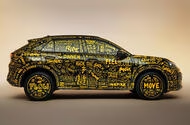What’s New with the Next-Generation VW T-Roc?
If you’ve been keeping an eye on Volkswagen’s SUV lineup, you’ll know the T-Roc has been a quiet success story. Now, the second-generation T-Roc is almost here, and it’s bringing some big changes—especially under the hood. So, what’s actually new, and why should you care? Let’s dive in.
How Is Volkswagen Changing the T-Roc’s Design?
First impressions matter, and Volkswagen clearly knows it. The new T-Roc’s official teaser shows off a more dynamic, sharply raked roofline—think sleeker, sportier, and a bit more coupe-like. This isn’t just a cosmetic tweak. A lower, more aggressive roofline hints at improved aerodynamics and a more youthful vibe, which is exactly what many buyers want in a compact SUV these days.
But it’s not just about looks. Volkswagen has a knack for blending style with practicality, so expect the new T-Roc to keep its versatile interior and everyday usability. If you’re hoping for a car that stands out in the school run parking lot without sacrificing space, this redesign should hit the sweet spot.
What’s the Big Deal About the New Hybrid Powertrain?
Here’s where things get really interesting. The upcoming T-Roc will debut Volkswagen’s first full-hybrid powertrain—a system that can run on petrol, electricity, or both, depending on what the situation calls for. If you’re familiar with how Toyota’s hybrids work, you’ll have a good sense of what to expect: smooth transitions between electric and petrol power, improved fuel efficiency, and a quieter drive in the city.
Why is this a big deal for VW? Until now, Volkswagen hasn’t offered this kind of hybrid in its production cars. Plug-in hybrids (PHEVs) have been around, but a full hybrid—where the car can switch seamlessly between power sources without plugging in—is new territory for the brand. It’s a smart move, especially as the auto industry faces a bit of an identity crisis: electric vehicle (EV) adoption is growing, but not as fast as some predicted, especially in markets like the US.
Why Is Volkswagen Betting on Hybrids Now?
Volkswagen’s CEO, Thomas Schäfer, put it plainly: different regions have different needs. In South America, for example, the demand for hybrid electric vehicles (HEVs) is strong, and the T-Roc is built there specifically with that market in mind. China is another key region, where hybrids are seen as a practical step toward full electrification.
Interestingly, hybrids are making a comeback in the US, too. While battery EVs grabbed headlines for years, recent data from the International Energy Agency shows that hybrid sales in the US surged by over 50% in 2023, while pure EV growth slowed. Consumers want better fuel economy and lower emissions, but many aren’t quite ready to go fully electric. Hybrids offer a comfortable middle ground.
Will This Hybrid Tech Show Up in Other Volkswagens?
Absolutely. Volkswagen isn’t stopping with the T-Roc. The same full-hybrid system will soon appear in the next Golf and Tiguan models. However, don’t expect every VW on the MQB platform to get the hybrid treatment. The company is being strategic, rolling out hybrids where they make the most sense and balancing them with plug-in hybrids (PHEVs) in other models.
This approach reflects a broader industry trend: carmakers are hedging their bets, offering a mix of powertrains to suit different markets and customer preferences. It’s not a one-size-fits-all world, and Volkswagen’s flexibility here is a smart play.
How Does This Fit into Volkswagen’s Long-Term Plans?
Europe’s push toward all-electric vehicles is no secret—by 2035, new petrol and diesel cars will be banned in the EU. Volkswagen knows it needs to go all-in on EVs eventually, but the road there isn’t straight. By introducing advanced hybrids now, VW is buying itself time to refine its electric offerings while still meeting the needs of buyers who aren’t ready to make the leap.
It’s a pragmatic move. According to a 2024 report from BloombergNEF, hybrids are expected to account for nearly 30% of new car sales in Europe by 2027, as infrastructure and consumer confidence in EVs continue to grow. Volkswagen’s hybrid push positions it well for this transitional period.
What Should Buyers Expect from the New T-Roc?
If you’re in the market for a compact SUV, the new T-Roc promises a lot: sharper looks, a cutting-edge hybrid powertrain, and the kind of everyday practicality VW is known for. Expect improved fuel economy, lower emissions, and a driving experience that’s both responsive and refined.
And if you’re not quite ready to plug in every night, this hybrid system could be the perfect bridge to the electric future. It’s not rocket science—just a smart, flexible approach to the changing world of cars.
Looking Ahead: Why the T-Roc’s Evolution Matters
The new T-Roc isn’t just another facelift. It’s a sign of how Volkswagen—and the auto industry as a whole—is adapting to a rapidly changing landscape. By offering more choices and smarter technology, VW is making it easier for drivers to find the right fit for their lives, wherever they are in the world.
So, whether you’re a longtime VW fan or just curious about what’s next in the world of hybrids, keep an eye out for the T-Roc’s official reveal. The outcome? Game-changing.

